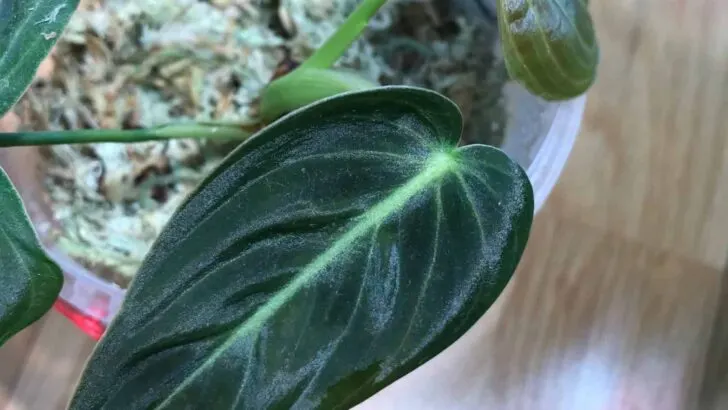You are here because you want to learn more about Philodendron melanochrysum care.
The Black Gold Philodendron is a rare and beautiful tropical plant. It is a climbing plant in the Aroid family (Araceae).
The dark green (almost black) crystalline leaves show a bright yellow venation. Smaller leaves emerge with a golden shine and turn into a dark green.
The yellow vein traces its’ way through the leaf to form a unique pattern. The leaves have a velvety texture that I just love to touch.
The crystalline appearance of the leaves resembles specks of gold.
In fact, “melanochrysum” means “black gold.” These attributes created the nickname the “Black Gold Philodendron.”
Like many other Philodendrons, The Melanochrysum Philodendron is a climbing plant.
Philodendron melanochrysum Takeaways
| Species | Philodendron melanochrysum |
| Synonyms | Black Gold Philodendron |
| Family | Araceae |
| Genus | Philodendron |
| Growth | Climbing plant |
| Height | 20 feet |
| Width | 1 feet |
| Soil | Well-draining chunky soil |
| Watering | Every 5 to 7 days |
| Light | Bright indirect |
| Temperature | 70 - 80°F |
| Humidity | 60 to 80% |
| Fertilizer | Fertilize twice a month |
| Propagation | Stem cuttings, seeds |
Table of Contents
Philodendron melanochrysum Care
To care for Philodendron melanochrysum use well-draining soil mix using potting soil with peat moss, perlite, orchid bark, and charcoal. Provide bright indirect light and a temperature between 70-80°F (21-27°C). Water once the soil’s top 2-3” (5.0-7.5cm) is almost dry. Water about once a week. Provide a humidity of >60% if possible. Fertilize once a month in spring and summer using a liquid fertilizer.
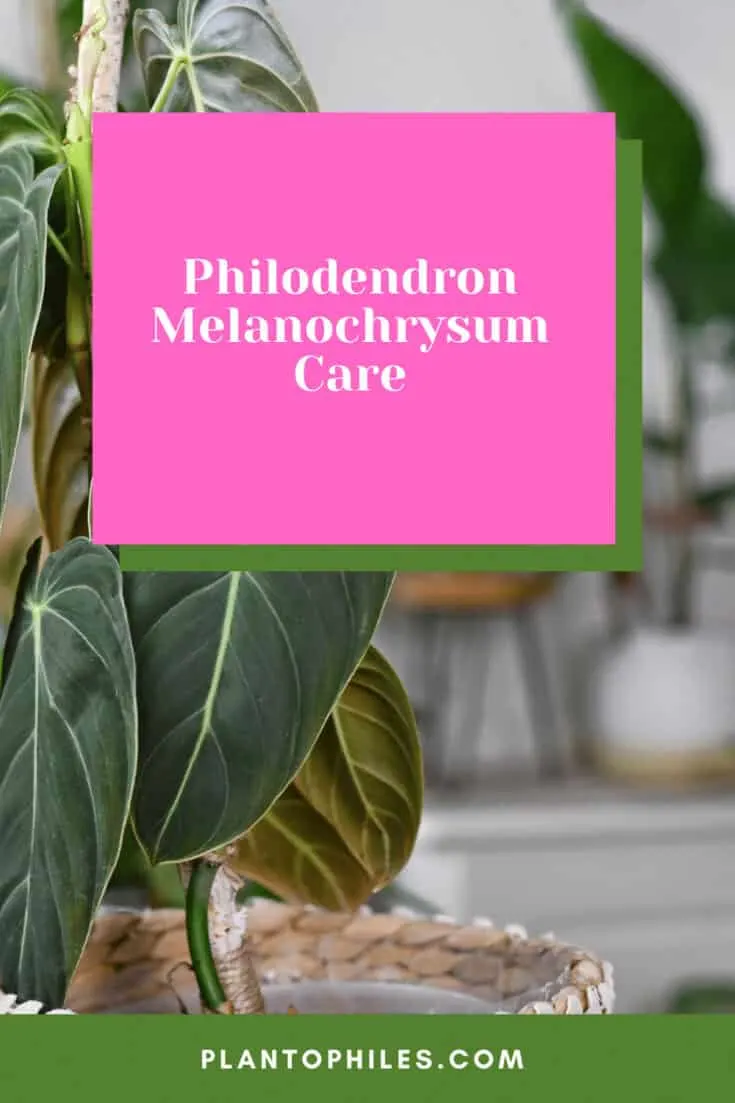
The plant originates from both Columbia and Costa Rica. It also comes from the West Indies.
The Philodendron melanochrysum plant is from the Araceae family, according to the University of Vermont.
Caring for a Philodendron melanochrysum is quite hard based on my experience. The leaves get stuck easily. The plant tends to grow leggy. Overwatering and root rot are constant risks.
I, therefore, created this ultimate guide to prove how simple caring for this plant is.
Are you ready to dig in? Pun intended!
Caring for a Philodendron melanochrysum
What Soil to use for a Philodendron melanochrysum
Philodendron melanochrysum soil needs to be airy and well-draining. An aroid mix using potting soil, peat moss, perlite, orchid bark, and charcoal is perfect for growing Philodendron melanochrysum.
The Philodendron Melano as some people call it is prone to wet feet (root rot), fungal diseases, and Bacterial Leaf Spot.
So, you want the soil to drain excess water through the drainage holes in the plant’s pot.
It should still hold enough water to hydrate the Philodendron melanochrysum.
Sphagnum peat moss is perfect as an ingredient for Philodendron plants. It’s airy enough to drain water.
But it can still hold onto the water it takes to keep your plant thriving.
Plus, it’s organic matter.
Philodendron melanochrysum plants do the best in soil with organic matter.
The downside of using Sphagnum peat moss is that while it’s airy, it can sometimes hold too much water. You have to be careful when watering the plant.

You can counteract this problem by using a hydroponic net pot. There’s more space for water to escape.
The pot also speeds up evaporation, so all that water won’t sit in the moss for long.
You must stay away from dry and sandy potting mixes when it comes to one of these plants.
Philodendron melanochrysum Light Requirements
Philodendron melanochrysum prefers bright indirect light.
You don’t want direct sunlight shining directly on your Philodendron melanochrysum.
It’s easy to burn the leaves of the plant. Direct sunlight also causes the yellowing of the leaves.
But it still needs some light to thrive. It’s not going to sit in complete darkness and grow.
The Philodendron genus consists of tropical plants. These plants live in a shady area with sunlight roaring above their’ shelter.
You need to place your plant in either an east-facing or north-facing window. This way plant continues to get light, but it’s not shining directly down on it.
If you use grow lights, you can place the plant about six inches away from the light.
Without sufficient light the Melanochrysum will grow leggy. Leggy growth is the result of insufficient light and no support. This is a vining Philodendron that grows in the understory of jungles.
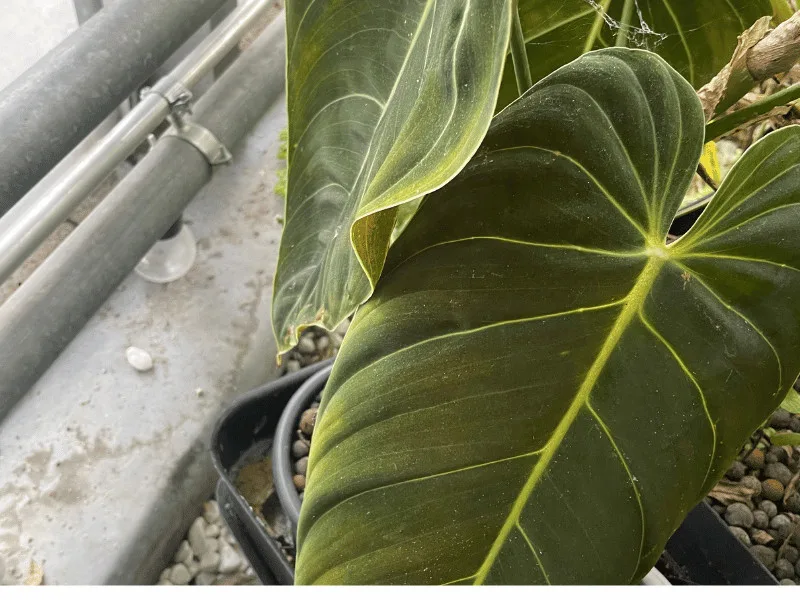
Take it Easy on the Watering
Water Philodendron melanochrysum once the top 2-3” of soil are almost dry about once a week.
For an even and healthy plant, you should always hydrate your Philodendron melanochrysum. The soil should never dry out.
Stick your finger in the soil to decide whether it’s time to water. Push your finger down until your knuckle hits the soil.
If it’s dry down to this level, it’s time to water. If not, wait a few more days and check again.
You need to always hydrate your plant but don’t want to over-water it.
As we stated earlier, it’s easy to over-water Philodendron melanochrysum plants.
One of the scariest repercussions of over-watering is root rot. When there’s too much water in the soil, oxygen can’t get through to the plant’s roots. With no oxygen supply to the roots, they decay or rot away.
The water should have a pH of between 5.5 pH to 6 pH.
Philodendron melanochrysum Temperature
A Philodendron melanochrysum thrives at a temperature between 70-80°F (21-27°C).
These plants can take temperatures down to 60F (15C). You don’t want to have the plant in any colder temperatures than that.
Philodendron melanochrysum Humidity
Philodendron melanochrysum grows best in humidity >60%.
A Philodendron melanochrysum doesn’t necessarily need high humidity to survive.
However, high humidity is still preferred, as it will make your Philodendron lusher and look healthier. For best results, aim for humidity over 60%.
There are options to creating humidity for your plant if you want to increase moisture.
First, you can mist your plant with water. When the water evaporates, mist your plant again. You’ll have to do this regularly.
The second option is to make a pebble tray for the Philodendron melanochrysum plant.
You fill a tray with pebbles. Then you fill the tray with water. Make sure the water doesn’t go above the pebbles. Place the plant pot on the tray.
As the water evaporates, it creates humidity. That humidity goes straight to your plant.
Refill the tray whenever all the water is gone.
I personally use a humidifier for my tropical plants.
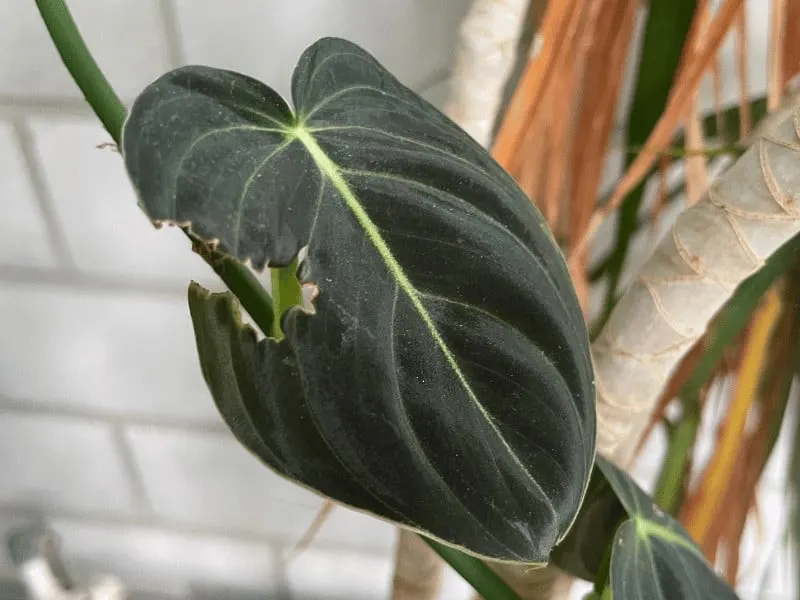
Fertilizer
Fertilize Philodendron melanochrysum in spring and summer using a balanced liquid fertilizer once every two weeks.
You should only fertilize your Philodendron melanochrysum plant when the soil is moist.
If you need to, lightly water it before you fertilize it.
Dry soil and fertilizer hurt a Philodendron melanochrysum’s roots.
The fertilizer you use should have a high amount of nitrogen.
This ensures the plant grows to a decent size.
Never fertilize during the offseason or the colder months. Only fertilize during the growing season.
Philodendron melanochrysum propagation
Propagate Philodendron melanochrysum using stem cuttings or through air layering.
The first is the traditional stem cuttings process.
The second is a technique known as “air layering.” The biggest benefit is that you can start with a rooted cutting when air layering. This increases the chances of success.
Growth
Philodendron melanochrysum is a slow to moderate grower. A new leaf every few months is the norm.
The Philodendron melanochrysum plant can grow between three and five feet in height (90-150cm). This is if the plant is grown indoors.
When a Philodendron melanochrysum is grown outside, it can grow to a towering 20 feet in height (6m).
The plant has leaves that can grow up to two feet in length.
These are very large plants. You need to have a room that can comfortably fit both the height of the plant and the length of the leaves.
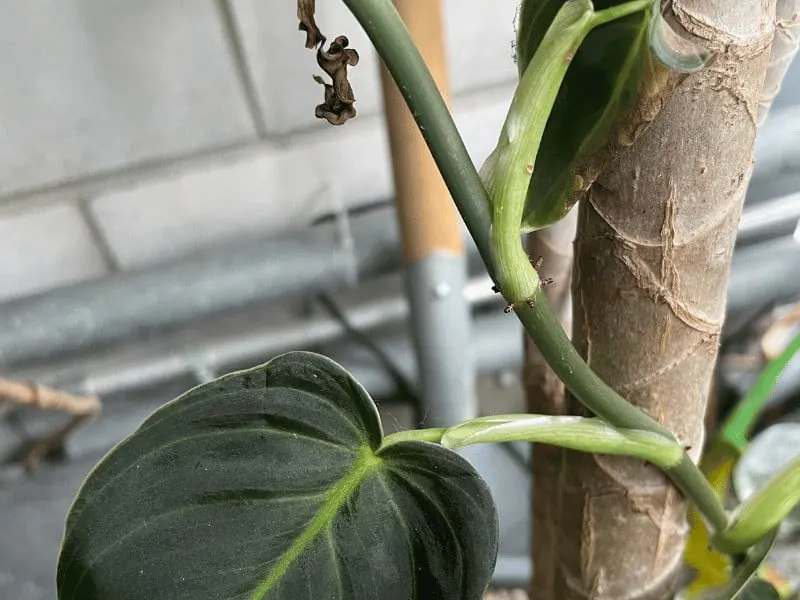
Potting
Re-potting a Philodendron melanochrysum is important. It’s based on your plant’s growth and how fast you’d like it to grow.
It takes a year to two years for one of these plants to outgrow its pots.
And once it grows too big for its’ pot, it’s time to move on up.
When you go to re-pot a Philodendron melanochrysum, only move it to a pot that’s a little bit bigger than the original.
Philodendron melanochrysum Propagation Steps
Propagating Philodendron melanochrysum plants can be an interesting process.
One method, air layering, is a lot different than the methods for other plants. It gives you a break from the same old routine.
But if you don’t want to switch up methods, you can still use the comfortable stem-cutting method.
You should always propagate a Philodendron melanochrysum during the growing season. Never during the off-season.
Using Stem Cuttings
- It’s time to get a stem cutting for propagation. To get a cutting, you need to prune one from your Philodendron melanochrysum plant. Always use pruning scissors. The stem cutting you prune should be between two and four inches long. This is so it’s able to take root. Make sure you cut the stem cutting right above a leaf node. There should be two leaves on the cutting, if not more.
- Before starting your second plant, you must cure your stem cutting. Curing is when one end of the cutting callouses over. Lay your stem cutting out for five to seven days. The cutting needs to sit out in a warm area of your home.
- While waiting for the cutting to cure, prepare the pot for your new Philodendron melanochrysum. Make sure you have well-draining soil, such as sphagnum peat moss.
- When your stem cutting callouses, it’s ready to plant. Make a small hole in the soil that will fit your cutting. Place the stem cutting in this hole.
- Sometimes stem cuttings aren’t able to support themselves. You can remedy this situation by tying a straw to the cutting.
- Now it’s time to take care of your new Philodendron melanochrysum plant. You care for it the same way you care for the mother plant.
Using Air Layering
- Your first step is to wound the stem of your Philodendron melanochrysum plant. You’ll need a sharp and clean knife. Cut the stem to make a wound about two inches in depth and length.
- Take a toothpick and stick it inside the wound. Position it so it’s holding the wound you created open.
- Now you need a handful of moist sphagnum peat moss. It has to be moist so it sticks to the plant’s stem. Rub the Sphagnum moss around the wound. If the Sphagnum moss dries, get it wet again so it stays sticking for the moment.
- Once you’ve applied the moss to the plant, tie a string around the moss. This will help hold the moss to the wound. This step isn’t required if the moss stays sticking while you do step five.
- Wrap plastic wrap around the wound. It should be larger than the wound area. Make sure you wrap it as tight as you can. Use duc tape or another strong tape to hold the plastic wrap on the plant. Now the sphagnum peat moss isn’t going anywhere.
- It takes two to three weeks for roots to grow from the sphagnum moss. Once the plant’s roots have grown to a decent length, you can remove the stem from your mother plant. Cut right above and right below the moss.
- Remove the plastic wrap from the stem cutting. You don’t have to worry about much of a mess now. Be careful with the roots.
- While waiting for the roots to grow, you should have gotten a pot with soil ready for your new plant. Plant your new roots.
- If the stem can’t hold itself up, tie a straw. But with roots, the cutting should be fine.
- Now you take care of your new plant. Water it, fertilize it, and make sure it gets adequate lighting. Watch it grow into a brand new Philodendron melanochrysum.
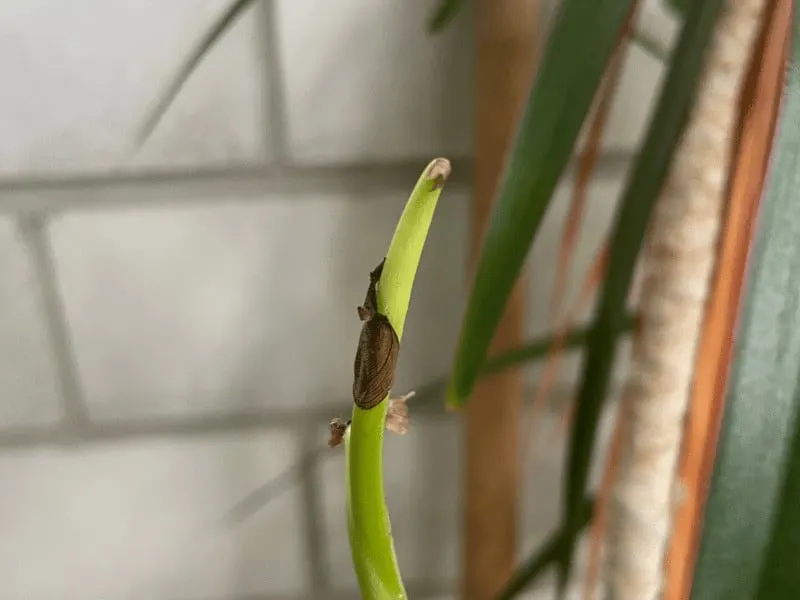
Philodendron melanochrysums Pests
As with any plant, some problems can arise when caring for a Philodendron melanochrysum.
Spider Mites
Philodendron melanochrysum is a spider mite magnet. I don’t know if it is the velvety texture or the nice large leaves, but spider mites are usually all over this plant. You spot then you get very close. Spider mites are read and quite small.
They form little fragile nets on the leaves that are hard to spot initially. It looks like there is a film on your Philodendron melanochrysum. Once you see these bugs crawling, you can confirm that you have a spider mite infestation.
I recommond using horticultural soap, neem oil, benefical nematodes or a systemic insecticide to get rid of the pests. Just be carefuls as the leaves of these houseplants are sensitive and might burn if the concentration of the insecticide is too high. Test on part of a leaf first before applying anything on all of the foliage.
Aphids
The first risk to worry about is the plant pest aphids. Aphids aren’t fun pests to deal with.
They have back legs that bend like a cricket’s and long antennas. I don’t want to discuss the cornicles that protrude from their back ends.
Looking at an aphid under a microscope would be terrifying.
Aphids are hard to get rid of because they reproduce like crazy. This means they multiple like crazy.
These pests feed off the sap or the lifeline of your Philodendron melanochrysum.
Stealing the sap means they steal the nutrition and hydration from the plant too.
Without these key elements, a plant can’t go into photosynthesis. It can’t feed itself or grow or thrive.
But that isn’t the only negative effect of these insects. Aphids carry plant diseases from one plant to another.
One disease spread to Philodendron melanochrysums from aphids is the Dasheen mosaic virus.
This plant virus starts with light green patterns tracing the front of your plant’s leaves. Feathery patches form between the veins.
In most cases, this virus doesn’t become serious. And the damage isn’t severe. But this is only one example of the many diseases carried by aphids.
Mealybugs
Mealybugs are another insect that likes to infest Philodendron melanochrysum plants.
These cottony pests feed off your plant as well.
Before you even know what’s happening, a small infestation has jumped to a large one. And large infestations are difficult to control or to get rid of.
The biggest sign of an infestation is cotton fluff on your plant, especially under the leaves. This is where the bugs like to hide.
Sometimes this cotton fluff looks like a spider’s web.
It’s important to eliminate mealybugs when you find out you have an infestation on your plant.
Some mealybugs feed off your plant’s roots instead of feeding on the leaves.
They’re hard to detect. You must pull your Philodendron melanochrysum out of its’ soil to examine the roots close up.
Most of the time, mealybugs aren’t detected until too late. These pests can end up damaging your plant for good. Or worse, they can kill your plant.
Philodendron melanochrysum small leaves
To get bigger leaves on Philodendron melanochrysum you need to use a moss pole. These Philodendrons are climbing plants and grow bigger leaves and stem as they grow taller. Attach the stem to a pole or trellis using velcro tape. Keep the moss slightly wet so aerial roots will grow into the support structure.
You can create a real moss pole as a DIY project at home.
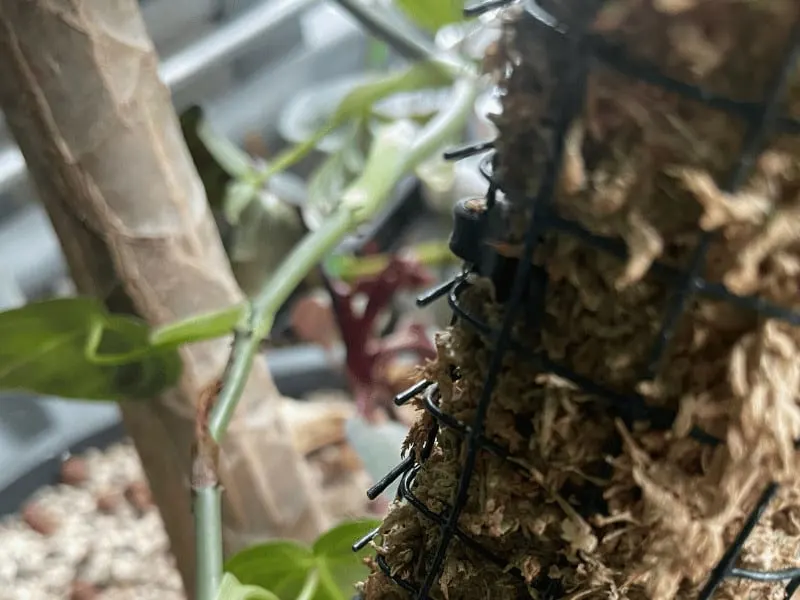
The leaves are stuck on my Philodendron melanochrysum
If the leaves are stuck the main reason is a lack of humidity. If you have low humidity at home or even regular humidity between 40-50%, the leaves often get stuck and tear.
To remedy this situation, you can use a spraying bottle and spray the stuck leaf. Using your hands or a qtip is not advised as you may damage the emerging leaf.
Leaf Drop on a Philodendron melanochrysum
If your Philodendron melanochrysum drops leaves, you may be overwatering your plant. Or you may have over-watered your plant enough that it has root rot.
You feel the soil to be sure between only over-watering and that your plant has root rot. You can usually tell if the soil is too saturated or not.
Next, you have to gently remove the Philodendron melanochrysum from its’ pot.
Examine the plant’s roots. The roots will be darker than they should be. And the roots will stink. They are rotting, after all.
It’s easy to correct the situation if you’re over-watering. You have to water your Philodendron melanochrysum plant less.
But if your plant has root rot, correcting the situation is harder.
A plant isn’t always salvageable. Since you don’t see root rot, it’s often caught too late.
You need to toss out a plant with root rot that’s too far advanced.
When you’re lucky enough to catch root rot early, you can try to save your Philodendron melanochrysum.
You have to clean the roots of your plant. Once you’ve cleaned the roots from dirt, sterilize pruning scissors. Isopropyl alcohol works well for sterilization.
With the pruning scissors, prune all the affected roots. When you’re finished, zero rotting roots should be connected to your plant.
Your Philodendron melanochrysum Has Brown Leaves
The symptom of brown leaves on a Philodendron melanochrysum can mean many things. Brown leaves can mean many conditions and issues.
But one of the lesser-known causes of brown leaves is the high salt in your plant’s soil.
Too much soluble salt comes from fertilizer. Every time you fertilize your plant, the salt adds up in the soil.
This is why it’s important to do a soil flush occasionally. Soil flushes are an easy process.
To do a soil flush, turn on your faucet slowly. Run the water over your plant’s soil for ten to fifteen minutes.
Let the water drain completely before you place your plant back in its’ usual spot.
Philodendron melanochrysum Brown spots
Brown spots indicate that your Philodendron melanochrysum has Bacterial Leaf Spot disease. To avoid this disease, allow for sufficient airflow and avoid spraying plant leaves too much. They need to be able to dry within 30 minutes max.
Wet environments create bacteria that attack your plant. The bacteria spread to plants in several ways, including by the wind.
According to the University of Minnesota, the necrotic spots start as a small dark spots on the leaf.
Ugly leaves aren’t the only consequence of Bacterial Leaf Spot. This plant disease can kill the leaves if not treated soon enough.
The best way to combat Bacterial Spot Disease is by immediately removing the infected parts.
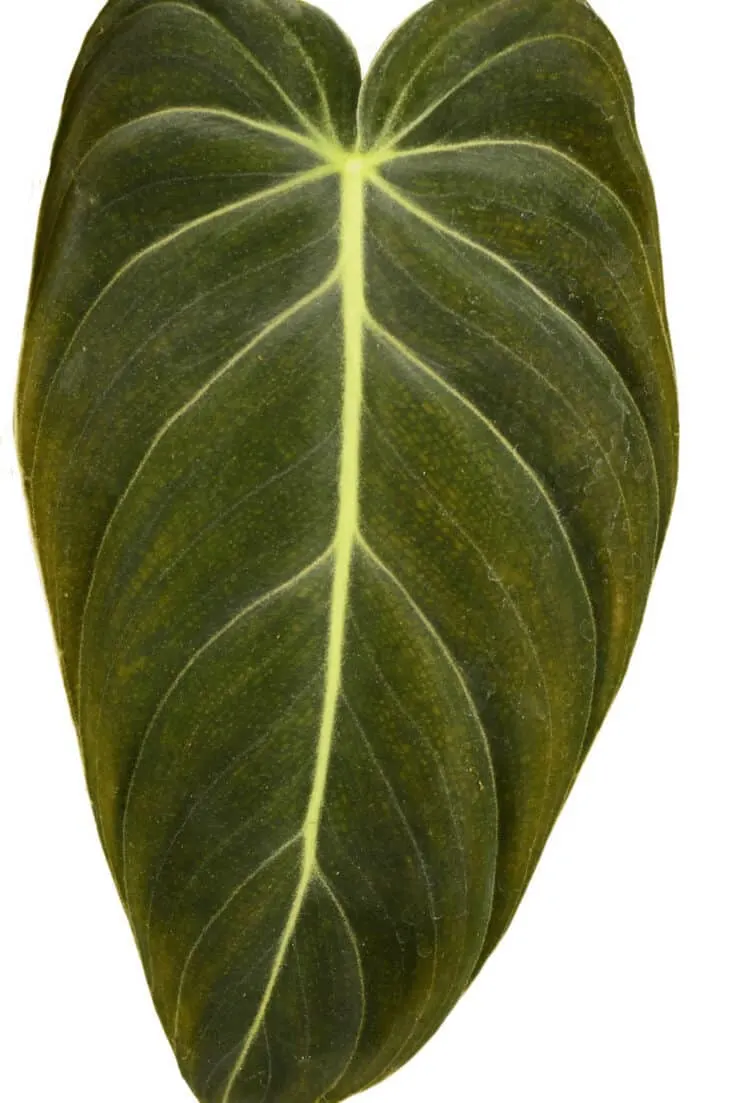
Other Philodendron Plants
The Philodendron melanochrysum plant isn’t the only Philodendron out there. The number of species would blow your mind.
Below are some of the more interesting species for you to check out.
Philodendron cordatum
Philodendron cordatums have glossy green heart-shaped leaves. They’re perfect as hanging plants since they vine out as they get bigger. Hang one on your indoor porch or in your living room.
Philodendron selloum
The Philodendron selloum has funky leaves. The leaves aren’t heart-shaped like many Philodendrons. Instead, they’re shaped like serrated fingers. Many serrated fingers.
Philodendron scandens micans
Philodendron scandes looks almost identical to the a juvenile Philodendron melanochrysum. The Philodendron micans plant is dark green with almost a purple tint to the leaves. They have a velvety texture that you’ll enjoy the feel of.
Philodendron angustisectum
Like the Philodendron selloum, this plant has glossy leaves that resemble many fingers. It can grow to amazing heights if it has room to do so. If you have a room with a high roof, see how big you can get yours to grow.
Philodendron melanochrysum x verrucosum
Philodendron melanochrysum x verrucosum is a cross between a Philodendron melanochrysum and a Philodendron verrucosum. The correct naming is Philodendron verrucosum x melanochrysum. The mother plant was a verrucosum and the father a melanochrysum. This clone is also called Philondendron Splendid and grows larger leaves than the verrucosum but inherts the red backsides adn yellow veining.
Generally crosses are easier to care for than the Philodendron melanochrysum.
Philodendron melanochrysum x gloriosum
The Philodendron melanochrysum x gloriosum is also called Philodendron Glorious. This hybrid looks like a Gloriosum but has a climbing habit. The veins are less pronounced than the Philodendron Splendind and green to beige. This cross can grow some very large leaves when allowed to climb. The Gloriosum itself is a crawler.
Frequently Asked Questions
Why are the leaves on my Philodendron melanochrysum turning funny colors?
Has your Philodendron melanochrysum plant been extra dusty? Dust clogs the pores of your plant, which causes it to turn different colors. Start dusting your plant regularly.
Why are the leaves on my Philodendron melanochrysum so small?
The leaves of Philodendron melanochrysum should be quite large. When the leaves aren’t growing, it means you aren’t fertilizing your plant enough. It’s not getting all the nutrients needed. You’ll need to start fertilizing it more often.
Are Philodendron melanochrysum plants toxic?
Philodendron melanochrysum plants are toxic when ingested. They contain calcium oxalate crystals. It’s toxic for both humans and pets. Some people develop a rash on their skin from touching the plant or the sap. Skin irritations are not uncommon.
Conclusion About Philodendron melanochrysum Care
- Soil: Use well-draining soil composed of potting soil, peat moss, perlite, orchid bark, and charcoal.
- Light: Provide bright indirect light.
- Temperature: Maintain a temperature between 70-80°F (21-27°C).
- Watering: Water once the soil’s top 2-3” (5.0-7.5cm) is almost dry, approximately once a week.
- Humidity: Aim for humidity >60% if possible.
- Fertilizing: Fertilize once a month in spring and summer using a liquid fertilizer.

Daniel has been a plant enthusiast for over 20 years. He owns hundreds of houseplants and prepares for the chili growing seasons yearly with great anticipation. His favorite plants are plant species in the Araceae family, such as Monstera, Philodendron, and Anthurium. He also loves gardening and is growing hot peppers, tomatoes, and many more vegetables.

